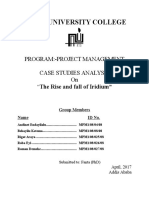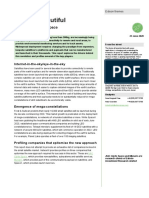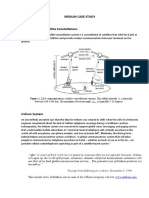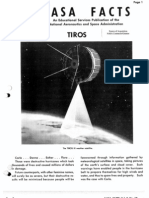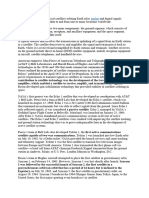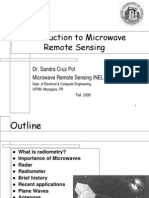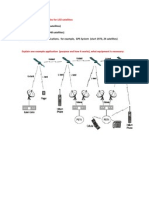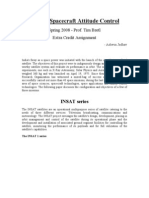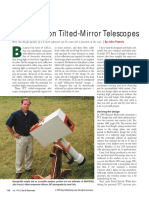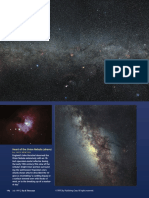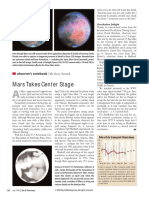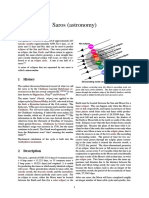0 ratings0% found this document useful (0 votes)
23 viewsAdvertisement: Iridium Satellites May Come Down Soon
Advertisement: Iridium Satellites May Come Down Soon
Uploaded by
Davor BatesIridium satellites that provided global phone service may soon be deorbited as the company declared bankruptcy. The satellites interfere with radio astronomy observations of hydroxyl emissions used to study stars. While astronomers will be relieved if the satellites are removed from orbit, it could take the satellite operator Motorola up to two years to deorbit all 90 satellites safely.
Copyright:
© All Rights Reserved
Available Formats
Download as PDF, TXT or read online from Scribd
Advertisement: Iridium Satellites May Come Down Soon
Advertisement: Iridium Satellites May Come Down Soon
Uploaded by
Davor Bates0 ratings0% found this document useful (0 votes)
23 views1 pageIridium satellites that provided global phone service may soon be deorbited as the company declared bankruptcy. The satellites interfere with radio astronomy observations of hydroxyl emissions used to study stars. While astronomers will be relieved if the satellites are removed from orbit, it could take the satellite operator Motorola up to two years to deorbit all 90 satellites safely.
Original Title
200007023023.pdf
Copyright
© © All Rights Reserved
Available Formats
PDF, TXT or read online from Scribd
Share this document
Did you find this document useful?
Is this content inappropriate?
Iridium satellites that provided global phone service may soon be deorbited as the company declared bankruptcy. The satellites interfere with radio astronomy observations of hydroxyl emissions used to study stars. While astronomers will be relieved if the satellites are removed from orbit, it could take the satellite operator Motorola up to two years to deorbit all 90 satellites safely.
Copyright:
© All Rights Reserved
Available Formats
Download as PDF, TXT or read online from Scribd
Download as pdf or txt
0 ratings0% found this document useful (0 votes)
23 views1 pageAdvertisement: Iridium Satellites May Come Down Soon
Advertisement: Iridium Satellites May Come Down Soon
Uploaded by
Davor BatesIridium satellites that provided global phone service may soon be deorbited as the company declared bankruptcy. The satellites interfere with radio astronomy observations of hydroxyl emissions used to study stars. While astronomers will be relieved if the satellites are removed from orbit, it could take the satellite operator Motorola up to two years to deorbit all 90 satellites safely.
Copyright:
© All Rights Reserved
Available Formats
Download as PDF, TXT or read online from Scribd
Download as pdf or txt
You are on page 1of 1
Look out for Iridium satellite flares — while you can!
All 90 spacecraft may be brought down
in the wake of Iridium LLC’s bankruptcy. Dave Sewell of Wilmington, Delaware, photographed
this glint of reflected sunlight from Iridium satellite number 16 on March 7th. He used an
Olympus OM-1 camera with a 50-millimeter lens at f/4 to take a 10-second exposure on Kodak
200 Elite II film. See www.heavens-above.com for your local Iridium flare predictions.
Iridium Satellites May Come Down Soon
Astronomers have had mixed feelings the spacecraft emerges.
about the Iridium network of communi- Scott Wyman, a spokesman for Mo-
cations satellites, which was established to torola, Inc. (the company that built the
enable globetrotters to use portable tele- satellites and retains remote control of
phones any place on Earth. Since their them), told Sky & Telescope that “the po-
debut in 1997 the spacecraft have delight-
ed many skywatchers by briefly reflecting
tential to deorbit was built into the de-
sign” of the satellites, and “Iridium and Advertisement
sunlight as they creep across the sky, cre- the court” have given Motorola permis-
ating flares that can outshine Venus for sion to do so — the motivation being
several seconds (S&T: May 1998, page long-standing U.S. space policy to mini-
36). However, they have also interfered mize debris in low Earth orbit. But nei-
with radio observations of emissions ther Wyman nor Iridium lawyer Casey
from the important hydroxyl (OH) radi- Rice would say how or when this will be
cal. Those emissions are used to study done. Aviation Now reports that it could
cool stellar atmospheres and star-form- take Motorola up to two years to bring
ing clouds. Prohibited in principle by in- all the spacecraft down into the Earth’s
ternational law, this radio interference atmosphere, where they would burn up.
has prompted lengthy and contentious As this issue of Sky & Telescope went to
negotiations between astronomers and press Motorola was still operating the
the satellites’ owners and operators satellite network, and its strong signals
(S&T: December 1998, page 16). were still being picked up by interference
Now it appears that astronomers may monitors at the Very Large Array radio-
not have Iridium in their skies much telescope site in New Mexico.
longer. Iridium LLC, the company that If the satellites really are brought down
owned the satellites and ran the system, or at least turned off, Iridium’s failure
declared bankruptcy last year, along with will provide a respite for the dedicated
several affiliated entities. Collectively cadre of radio astronomers who spent
they owe creditors more than $1 billion. years fighting Motorola and Iridium for
With ordinary cellular-telephone net- radio-quiet skies. “When I started out,
works rapidly expanding, far too few this was a hobby,” says Westerbork Ob-
customers were willing to pay as much servatory director Willem Baan, refer-
as $3,000 for a special Iridium tele- ring to the spectrum-usage negotiations
phone and up to $7 per minute to use he carried out throughout the 1990s.
it. On March 17th Iridium asked the Now, he says, it’s clear that radio obser-
U.S. Bankruptcy Court for permission vatories and astronomy funding agencies
to “commence the de-orbiting of the need to support full-time efforts to save
Iridium Satellites” if no serious bid for critical scientific frequencies.
©2000 Sky Publishing Corp. All rights reserved. Sky & Telescope July 2000 23
You might also like
- MIT8 01SC Problems28 Soln PDFDocument22 pagesMIT8 01SC Problems28 Soln PDFRavi RoyNo ratings yet
- Series Screenwriter Portfolio by SlidesgoDocument46 pagesSeries Screenwriter Portfolio by SlidesgoSofia MoraNo ratings yet
- Acta MesoamericanaDocument260 pagesActa MesoamericanaMarcos EstevamNo ratings yet
- Advertisement: Iridium Satellites May Come Down SoonDocument1 pageAdvertisement: Iridium Satellites May Come Down SoonDavor BatesNo ratings yet
- Assignment#2 The Rise and Fall of Iridium FinalDocument9 pagesAssignment#2 The Rise and Fall of Iridium FinalAndinetNo ratings yet
- Wiki Iridium CommunicationsDocument9 pagesWiki Iridium CommunicationsUdit SatijaNo ratings yet
- Space Themes 260620Document14 pagesSpace Themes 260620Matias LipskerNo ratings yet
- Rocket Report: China Discovers Grid Fins, NASA Acknowledges Starship ProgramDocument5 pagesRocket Report: China Discovers Grid Fins, NASA Acknowledges Starship ProgramSãröj ShâhNo ratings yet
- 05 Satellite Systems040612Document11 pages05 Satellite Systems040612Aman RoyNo ratings yet
- 2009 Iridium-Cosmos Collision FactsheetDocument3 pages2009 Iridium-Cosmos Collision FactsheetPratiwi NingrumNo ratings yet
- Iridium CaseDocument4 pagesIridium CaseViktoriia TotikovaNo ratings yet
- C-SIGMA Article March-April 2011Document4 pagesC-SIGMA Article March-April 2011timh1123No ratings yet
- 15arspc Submission 48Document12 pages15arspc Submission 48reneebartoloNo ratings yet
- Case Study About The Rise and Fall ofDocument13 pagesCase Study About The Rise and Fall ofAbhishek Singh33% (3)
- European Incoherent Scatter Scientific Association EISCATDocument2 pagesEuropean Incoherent Scatter Scientific Association EISCATNida Tuz ZohraNo ratings yet
- Solar Power Satellites: A Visual Introduction: Prepared By: Ishita Bhatt (15MEE03)Document37 pagesSolar Power Satellites: A Visual Introduction: Prepared By: Ishita Bhatt (15MEE03)IshitaBhatt30No ratings yet
- RadwetDocument22 pagesRadwetXteqqNo ratings yet
- ECEG30 History of Satellite CommunicationDocument4 pagesECEG30 History of Satellite CommunicationRJ BragaNo ratings yet
- Earthrise (1990) (Interstel Corporation) (Manual)Document18 pagesEarthrise (1990) (Interstel Corporation) (Manual)jeanjean33No ratings yet
- Nasa Facts TirosDocument8 pagesNasa Facts TirosBob AndrepontNo ratings yet
- Research PaperDocument14 pagesResearch Paperhithj05No ratings yet
- C4ISR (MAR 2013) The Bermuda Triangle of SpaceDocument6 pagesC4ISR (MAR 2013) The Bermuda Triangle of SpaceChris B.No ratings yet
- Iridium20thcenturysavv1 100427183903 Phpapp02Document26 pagesIridium20thcenturysavv1 100427183903 Phpapp02Tuhin AnandNo ratings yet
- Canadian Cosmos ClaimDocument16 pagesCanadian Cosmos ClaimvinuNo ratings yet
- Operations in Space: Moral, Miraflor, de VeraDocument22 pagesOperations in Space: Moral, Miraflor, de VeraRhea CelzoNo ratings yet
- Heavy TrafficDocument3 pagesHeavy TrafficWilliam RiveraNo ratings yet
- NASA Facts Lightning and The Space Program 1998Document12 pagesNASA Facts Lightning and The Space Program 1998Bob Andrepont100% (1)
- Iridium Satellite TechnologyDocument5 pagesIridium Satellite TechnologyPallavi Kammaje SeetharamNo ratings yet
- Settlite CommunicationDocument9 pagesSettlite CommunicationsajidNo ratings yet
- ODQNv19i1 PDFDocument10 pagesODQNv19i1 PDFsyrijal26No ratings yet
- Space Weather Super-Storm Not IF But WHEN and Extreme Solar MinimumDocument30 pagesSpace Weather Super-Storm Not IF But WHEN and Extreme Solar Minimumbergindo7318No ratings yet
- IndexDocument19 pagesIndexGaurav GulatiNo ratings yet
- Applications of SatelliesDocument34 pagesApplications of SatelliescooljseanNo ratings yet
- Terrorism - Satellite ReconnaissanceDocument3 pagesTerrorism - Satellite ReconnaissanceSimon BenjaminNo ratings yet
- Collateral Damage To Satellites From An EMP Attack: August 2010Document165 pagesCollateral Damage To Satellites From An EMP Attack: August 2010Nate LevineNo ratings yet
- CollisionDocument10 pagesCollisionJose MartinsNo ratings yet
- A History of PhotovoltaicsDocument4 pagesA History of Photovoltaicspriyanshi12No ratings yet
- SpaceX - Starlink GenDocument3 pagesSpaceX - Starlink Genmichaelkan1No ratings yet
- Research On Satellite CommunicationsDocument5 pagesResearch On Satellite CommunicationskamupataNo ratings yet
- What Is Satellite Radio?: SatellitesDocument4 pagesWhat Is Satellite Radio?: SatellitescolcasatNo ratings yet
- Marconi Radar 1946-1986Document18 pagesMarconi Radar 1946-1986bayman66No ratings yet
- Radar: From Wikipedia, The Free EncyclopediaDocument19 pagesRadar: From Wikipedia, The Free EncyclopediaaadhavanshinesNo ratings yet
- Communications Satellite: Citations VerificationDocument9 pagesCommunications Satellite: Citations VerificationPrasad Durga PrasadNo ratings yet
- Introduction To Microwave Remote SensingDocument28 pagesIntroduction To Microwave Remote SensingbingwazzupNo ratings yet
- Radar ProjectDocument42 pagesRadar Projectgautam yadavNo ratings yet
- NASA Facts Making A Deep Impact July 2005Document2 pagesNASA Facts Making A Deep Impact July 2005Bob AndrepontNo ratings yet
- Lec 1Document44 pagesLec 1NI-hal SaadNo ratings yet
- Overview of IRIDIUM Satellite NetworkDocument9 pagesOverview of IRIDIUM Satellite NetworkBhushan ShilwarNo ratings yet
- India Signs Tax Information Exchange Agreement With MonacoDocument84 pagesIndia Signs Tax Information Exchange Agreement With MonacoRakesh HazaribaghNo ratings yet
- Prob 1993Document4 pagesProb 1993Dione HUNo ratings yet
- Draconid Meteorite ShowerDocument15 pagesDraconid Meteorite ShowerAviation/Space History LibraryNo ratings yet
- Space Debris SeminarDocument40 pagesSpace Debris SeminarAnshul KhandelwalNo ratings yet
- CarringtonDocument29 pagesCarringtonTaryn Lee AverittNo ratings yet
- Solve of LEODocument3 pagesSolve of LEOAli Sa'adNo ratings yet
- Geostationary Orbit: Aces East Asia South Asia Southeast Asia Inmarsat ShipsDocument2 pagesGeostationary Orbit: Aces East Asia South Asia Southeast Asia Inmarsat ShipssathishNo ratings yet
- Appeal Court Ruling FCC Viasat DishDocument18 pagesAppeal Court Ruling FCC Viasat Dishmichaelkan1No ratings yet
- Getting Started in Radio Astronomy: Beginner Projects for the AmateurFrom EverandGetting Started in Radio Astronomy: Beginner Projects for the AmateurNo ratings yet
- IridiumDocument2 pagesIridiumimranahmad969640No ratings yet
- Koller-Thompson LightPollution 20201026Document8 pagesKoller-Thompson LightPollution 20201026Mahbub AlahiNo ratings yet
- Meteorological Satellites and Sounding RocketsDocument25 pagesMeteorological Satellites and Sounding RocketsBob AndrepontNo ratings yet
- Space Based Solar Power - WikiDocument13 pagesSpace Based Solar Power - WikiShreyankur TripathiNo ratings yet
- Jadhav FinalPaperDocument15 pagesJadhav FinalPaperDeepthi DsouzaNo ratings yet
- Radar: Echoes of Silent Vigilance, Unveiling the Technological SentinelFrom EverandRadar: Echoes of Silent Vigilance, Unveiling the Technological SentinelNo ratings yet
- A Challenging Globular Cluster Marathon: Observer's NotebookDocument2 pagesA Challenging Globular Cluster Marathon: Observer's NotebookDavor BatesNo ratings yet
- The Best Skywatching Season: Guide To The Evening SkyDocument2 pagesThe Best Skywatching Season: Guide To The Evening SkyDavor BatesNo ratings yet
- Follow Along As An Astronomer-Astronaut Visits The Ailing Hubble Space Telescope And, Along With His Crewmates, Restores It To Electronic and Mechanical Health. by John M. GrunsfeldDocument7 pagesFollow Along As An Astronomer-Astronaut Visits The Ailing Hubble Space Telescope And, Along With His Crewmates, Restores It To Electronic and Mechanical Health. by John M. GrunsfeldDavor BatesNo ratings yet
- Ere SK: When To Use The MapDocument1 pageEre SK: When To Use The MapDavor BatesNo ratings yet
- Calendar Notes: CeresDocument2 pagesCalendar Notes: CeresDavor BatesNo ratings yet
- Update: MissionDocument1 pageUpdate: MissionDavor BatesNo ratings yet
- Astronomers Are Curious About Why Some Leonid Meteors Leave in The SkyDocument4 pagesAstronomers Are Curious About Why Some Leonid Meteors Leave in The SkyDavor BatesNo ratings yet
- Calendar Notes: ©2000 Sky Publishing Corp. All Rights ReservedDocument1 pageCalendar Notes: ©2000 Sky Publishing Corp. All Rights ReservedDavor BatesNo ratings yet
- 199907128133Document6 pages199907128133Davor BatesNo ratings yet
- Better Solar-Storm Forecasting: 14:27 U.T. 14:59 U.TDocument2 pagesBetter Solar-Storm Forecasting: 14:27 U.T. 14:59 U.TDavor BatesNo ratings yet
- Letters: Taurus The Ram and Aries The Bull?Document2 pagesLetters: Taurus The Ram and Aries The Bull?Davor BatesNo ratings yet
- GalleryDocument3 pagesGalleryDavor BatesNo ratings yet
- Now Boarding: Before Going Abroad, Understand The RisksDocument2 pagesNow Boarding: Before Going Abroad, Understand The RisksDavor BatesNo ratings yet
- A Teaching Pioneer: Star TrailsDocument2 pagesA Teaching Pioneer: Star TrailsDavor BatesNo ratings yet
- Imaging TotalityDocument6 pagesImaging TotalityDavor BatesNo ratings yet
- Mars Takes Center Stage: Observer's NotebookDocument1 pageMars Takes Center Stage: Observer's NotebookDavor BatesNo ratings yet
- Orbital View of Home: Screen ShotDocument1 pageOrbital View of Home: Screen ShotDavor BatesNo ratings yet
- A Jupiter Observing Guide: Observer's LogDocument6 pagesA Jupiter Observing Guide: Observer's LogDavor BatesNo ratings yet
- Advertisement: Updating The Fate of The UniverseDocument1 pageAdvertisement: Updating The Fate of The UniverseDavor BatesNo ratings yet
- Comet LINEAR Comes and Goes: Observer's NotebookDocument1 pageComet LINEAR Comes and Goes: Observer's NotebookDavor BatesNo ratings yet
- Raining Raining Raining Raining Raining Raining Raining RainingDocument7 pagesRaining Raining Raining Raining Raining Raining Raining RainingDavor BatesNo ratings yet
- Galaxy Bars: Fueling Active Nuclei?: Martin Schwarzschild, 1912-97Document1 pageGalaxy Bars: Fueling Active Nuclei?: Martin Schwarzschild, 1912-97Davor BatesNo ratings yet
- Have You Been by Iridium?: FlashedDocument6 pagesHave You Been by Iridium?: FlashedDavor BatesNo ratings yet
- Dwindling Deuterium: More Moons For UranusDocument1 pageDwindling Deuterium: More Moons For UranusDavor BatesNo ratings yet
- CL X Atmospheric Refraction With QuesDocument7 pagesCL X Atmospheric Refraction With QuesarnavguptaNo ratings yet
- The Doppler Effect With SoundDocument6 pagesThe Doppler Effect With SoundWilfred Wafo FonwouoNo ratings yet
- Telugu Mulugu Panchangam 2013 2014 Download - Telugu Gantala Panchangam March 2013 2014 - Rasi and Nakshtram Predictions Astrology 2012 - Characteristics of Nakshatram in TeluguDocument1 pageTelugu Mulugu Panchangam 2013 2014 Download - Telugu Gantala Panchangam March 2013 2014 - Rasi and Nakshtram Predictions Astrology 2012 - Characteristics of Nakshatram in Telugusujiv_sujiv1278No ratings yet
- VedicReport7 10 20208 51 17PM PDFDocument56 pagesVedicReport7 10 20208 51 17PM PDFprajjwal singhNo ratings yet
- 2 - ch10 - SQ - E: Solutions MarksDocument16 pages2 - ch10 - SQ - E: Solutions Marks黃家熙No ratings yet
- Đề Cương Ôn Tập Giữa Hk2 Ta8 Smart World Đáp ÁnDocument22 pagesĐề Cương Ôn Tập Giữa Hk2 Ta8 Smart World Đáp ÁnKiều NhiNo ratings yet
- Phase-1 Prac Nav Sec-B Q#6Document33 pagesPhase-1 Prac Nav Sec-B Q#6Mriganka Mouli Ghosh100% (2)
- Overview Numerical Integrators Pag 11-15Document5 pagesOverview Numerical Integrators Pag 11-15SZUCS IMNo ratings yet
- Angela Merkel Horoscope Life DestinyDocument20 pagesAngela Merkel Horoscope Life DestinyHummels1000No ratings yet
- 01-2024 Gemini Horoscope For January 2024 - Susan Miller Astrology ZoneDocument4 pages01-2024 Gemini Horoscope For January 2024 - Susan Miller Astrology ZoneDenis FernandoNo ratings yet
- AstrologyDocument10 pagesAstrologyNaveen KumarNo ratings yet
- Aa4262 05Document13 pagesAa4262 05abdelmoamen nosirNo ratings yet
- Understanding Mercury Retrograde - How It Affects Us in Astrology - Times of IndiaDocument2 pagesUnderstanding Mercury Retrograde - How It Affects Us in Astrology - Times of IndiaAgustina CandelariaNo ratings yet
- Biography Text of Tsabit Bin Qurrah (Elok Uswatun Khasanah, 190210101100)Document2 pagesBiography Text of Tsabit Bin Qurrah (Elok Uswatun Khasanah, 190210101100)elok uswatun khasanahNo ratings yet
- Dasa ADocument62 pagesDasa ARakesh SinghNo ratings yet
- Astronomy Understanding The Universe PDFDocument98 pagesAstronomy Understanding The Universe PDFcorazondelsur4021100% (2)
- Outline of Academic Disciplines - WikipediaDocument34 pagesOutline of Academic Disciplines - WikipediaUtility ZCNo ratings yet
- British Astronomical Association: JournalDocument68 pagesBritish Astronomical Association: JournalRonan NewmanNo ratings yet
- Done Competency 1-2 ADocument3 pagesDone Competency 1-2 AAmador ClannyNo ratings yet
- Hodder 2014 - Topic E Astrophysics - Physics - IB - DIPLOMA - 146523Document57 pagesHodder 2014 - Topic E Astrophysics - Physics - IB - DIPLOMA - 146523AngelNo ratings yet
- GravitationbookDocument31 pagesGravitationbookAnirudha SharmaNo ratings yet
- Lesson Plan v7Document4 pagesLesson Plan v7RowbeeliciousNo ratings yet
- Wider World 4 Grammar Presentation 5 2Document5 pagesWider World 4 Grammar Presentation 5 2veronika rugunNo ratings yet
- MercuryDocument1 pageMercuryd k patelNo ratings yet
- Planets LordsDocument10 pagesPlanets LordsMrithasanjeevaniNo ratings yet
- Saros (Astronomy)Document5 pagesSaros (Astronomy)Polad GhNo ratings yet
- Back To The PresentDocument15 pagesBack To The PresentMichaela Joice BalayanNo ratings yet




